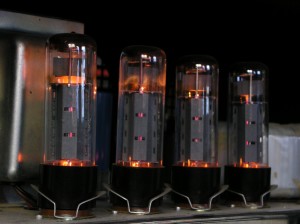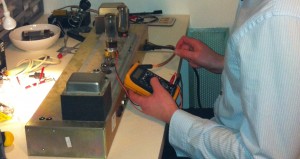Valve Amp Bias for Guitarists
Here’s a simple guide to biasing for guitarists. Biasing sets the amount of current running through a valve when there’s no signal.
Jargonese:
- Hot and Cold Bias
- Very ‘cold’ biasing can result in crossover distortion, which most find unpleasant.
- ‘Cold’ biasing – Higher fidelity, less distortion, longer tube life.
- ‘Hot’ biasing more power is dissipated (wasted) in the valve. This reduces headroom and increases power amp overdrive. many like this sound.
- Very ‘hot’ bias can reduce valve life and potentially damage your amp.
- Fixed Bias – This means that the bias is adjustable! Confusing? Yes. Try thinking of it as ‘Bias that has to be fixed by a technician or competent engineer’.
- Cathode biased – the bias is set by the circuitry in the amp. So the circuitry adjusts itself to match the valves. Handy!
- Red-plate – Not good! Valves glow a very bright pinky red all the way up the plates in the tube. Often means bias is too high.

Is valve amp bias always necessary for new valves?
No. Here are 2 exceptions.
-
- Cathode biased amps do not normally need biasing. Often smaller amps (<30W) are cathode biased. This includes many designs using EL84s and 6V6s. If you change tubes in a cathode biased amp and the tubes red-plate, take the amp to a tech.
- Mesa boogie state that you should only use their tubes. This is because during design they have permanently set the bias current for optimum performance with own brand tubes. Boogie get a lot of stick for this on ‘the forums’, but I’d say their reasoning is sound. You don’t need to bias if you buy Boogie valves for a Boogie amp.
OK, so can I do my own valve amp bias?
Some manufacturers (eg. some modern marshalls) provide a bias port on the back of the amp. If you know how to use a multimeter you can place one across these pins and adjust the preset potentiometers to give the correct reading (given by manufacturer). The values change from amplifier to amplifier.
If your amp doesn’t have external bias pots then I would strongly recommend against doing your own biasing. Valve amp bias must be done on a live amp – operating on a live valve amp is extremely dangerous if you don’t know what you’re doing. The voltages (often 300-700VDC) and currents involved can kill you easily. Take the amp to a tech.

I’ve got a fixed bias amp, but I put new valves in and turned the amp on. It sounds fine, is it?
Possibly, possibly not.
Many people have their own ways of biasing an amp. I’ve heard of people turning the valves up till they ‘red plate’ and then just backing off a bit. Some users adjust only by ear. I would recommend against these techniques and advocate either biasing to a value specified in manufacturers guidelines or to a value calculated to give sensible dissipation in the power tubes. Biasing by ear or sight (or smell!!) could reduce valve life or damage your amp.
My amp needs biasing and I don’t like maths!
Please get in touch, the cost of valve amp bias is £50 and includes testing of all valves on a valve tester.
